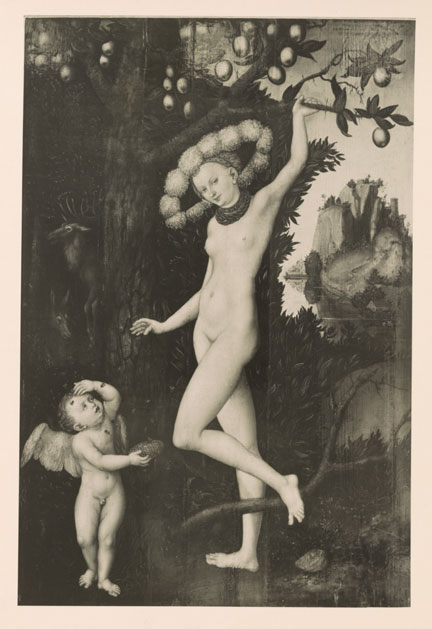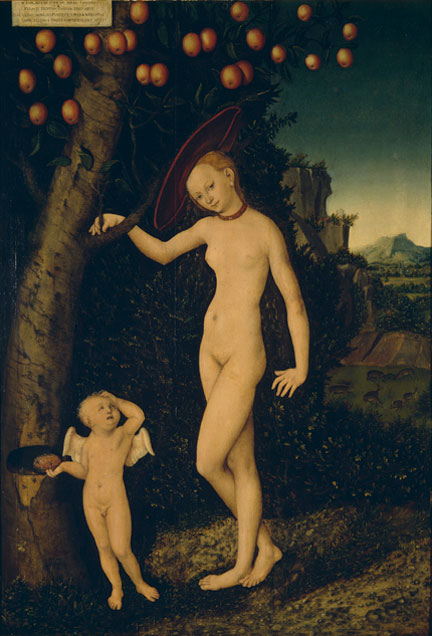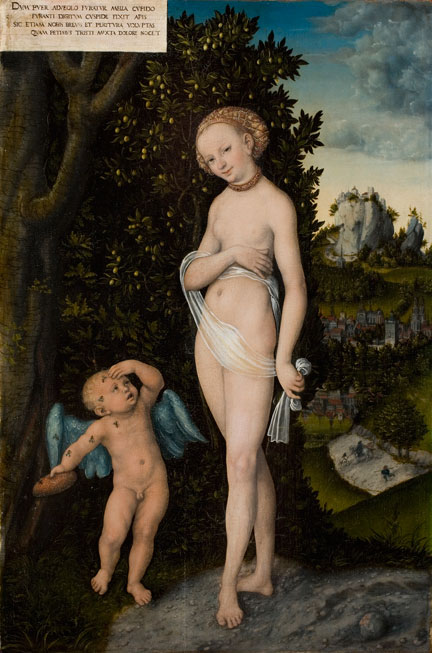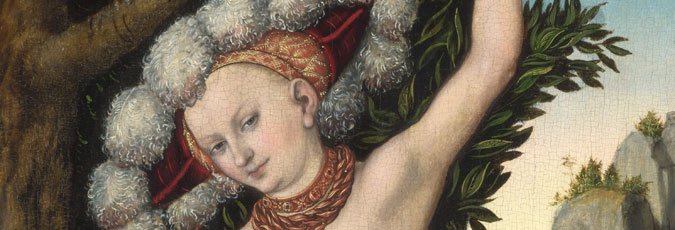Lucas Cranach the Elder
NG 6344
Cupid complaining to Venus
Oil on masonite board with mahogany veneer, 82.1 x 55.8 cm
Signature and inscriptions, provenance, and versions
Signature and inscriptions
Signed with Cranach’s serpent insignia facing left with elevated wings on stone below the left foot of Venus.
Inscribed: DVM PVER ALVEO[LO] F[VRATUR ME]LLA CUPIDO/ FURANTI DIGITVM CV[SPIDE] F[IXIT] APIS/ SIC ETIAM NOBIS BREVIS ET [PERI]TVRA VOLUPTAS/ QUAM PETIMUS TRI[S]T[I] [M]IXTA DOLORE N[O]CET (‘Young Cupid was stealing honey from a hive when a bee stung the thief on the finger. So it is for us: the brief and fleeting pleasure we seek/ is mingled with sadness and brings us pain’).
Provenance
The picture is first recorded in the sale of the collection of Emil Goldschmidt (1848–1909), Frankfurt, at Rudolph Lepke, Berlin, on 27 April 1909 (48), clearly identified through the photograph in the sale catalogue.1 The purchaser at the 1909 sale was an art dealer who has not been identified.2
This may be the painting by Lucas Cranach of ‘Venus und Amor als Honigdieb’, of similar but not identical dimensions, that was recorded as being sold by the widow of the Chemnitz businessman Hans Hermann Vogel (1867–after 1931) through Heinemann in Munich on 12 September 1935 to ‘Allmer, Berlin’. The latter can possibly be identified as Robert Allmers (1872–1951), president of the German Automobile Industry Association.3 It was acquired by Adolf Hitler (1889–1945) at an unknown date and is recorded in a photograph in an album that includes works from his private collection displayed at the Berghof, Berchtesgarten, Obersalzberg (fig. 1).4 Hitler was said in 1947 to have had a painting by Cranach of ‘Venus and Amor’ in the flat in Munich in which he lived from 1929 onwards.5 The painting may have been the work acquired by him in or before 1937, when he is said to have owned a recently acquired but unspecified work by Cranach.6 It may be the painting by Cranach that he is said to have acquired with royalties from the sales of 'Mein Kampf'.7

The painting was owned from 1945 by Mrs Patricia Lochridge Hartwell (1916–1998), an American war correspondent who was permitted to select it from a warehouse controlled by American forces in southern Germany in 1945.8 Mrs Hartwell sold it in 1963 through E. & A. Silberman, New York; according to Silberman it was sold ‘by family descendents’ of the purchasers at the 1909 sale (see above).9 It was bought by the National Gallery from Silberman in 1963.


Versions10
1. Schwerin, Museum Schloss Güstrow, 1527 (fig. 2).
2. New York, private collection.11
3. Copenhagen, Statens Museum, 1530 (fig. 3).
4. Switzerland, private collection (formerly Weimar), 1530.12
5. Formerly with Frederick Mount, New York, c.1530.13
6. Private collection, New York, 1531.14
7. Rome, Galleria Borghese, 1531.15
8. Brussels, Musée des Beaux-Arts, 1531.
9. London, private collection, 1532.16
10. Stuttgart, Staatsgalerie, 1532, fragment with Cupid only.
11. Kronach, Fränkische Galerie, 1534.17
12. London, Bonham’s, 4 December 2013 (60), dated 1537.
13. Nuremberg, Germanisches Nationalmuseum, c.1537.
14. Nuremberg, Germanisches Nationalmuseum, post-1537 (with landscape).
15. Berlin, Gemäldegalerie, Staatliche Museen zu Berlin, post-1537.
16. Otterlo, post-1537.
17. Formerly New York Historical Society, sold Sotheby’s, New York, 12 January 1995 (151), c.1540.
18. Private collection, c.1540.18
19. Glasgow, Burrell Collection, 1545.
Further sections
- Introduction
- Signature and inscriptions, provenance, and versions
- Technical notes
- Subject
- Attribution and date
2. In the record of the sale in Blätter fur Gemaldekunde (1909), p. 74, it is recorded that the painting was sold for 13,000 Marks and that the buyer was an art dealer (Kh); I am grateful to Nancy Yeide for this reference. No annotated copy of this sale catalogue, which might record the identity of the buyer, has yet been discovered: for example, annotated copies in the collections of the RKD and the Frick Collection give no information regarding the purchase of this painting.
3. Panel, 83.0 x 56.5 cm, Heinemann no. 19262, sold by Frau Vogel of Chemnitz for 20,000 Marks; bought by Allmer for 32,000 Marks: http://heinemann.gnm.de/de/kunstwerk-2334.htm. I am grateful to Eyal Dolev for this suggestion. Of known versions (see Versions), the dimensions of NG 6344 are similar only to the painting then and now at Schwerin, which measures 83.0 x 58.2 cm, and is therefore slightly broader than NG 6344 and the Vogel painting; NG 6344 is slightly smaller than the Vogel painting.
4. Library of Congress, LOT 11373(11).
5. By Heinrich Hoffmann on 3 September 1947. Interrogation of Hoffmann 29 August 1947: ‘Hitler had the following works of art in his apartment in Grillparzerstrasse 8. Cranach “Venus and Amor”’: see NARA RG 260, M1946, Restitution Research Records 1945–50, Roll 0136, Blatt 128 (photo of document kindly supplied by Eyal Dolev). A painting by Cranach listed by the Central Collecting Point as ‘Eva, den Paradiesapfelpflückend’ evidently refers to the same work: Venus in NG 6344 is depicted making a similar gesture to Eve in other works by Cranach, see further below and Schwarz 2009, p. 110.
6. Ward Price 1937, p. 20: ‘He recently acquired a Cranach and two Brueghels for his Munich flat’ and ibid., p. 27: ‘The principal living room is long and new. The walls are hung with a display of pictures … In addition to a fifteenth-century Cranach …’ .
7. According to Heinrich Hoffmann’s memoirs: information kindly supplied by Anne Webber. Although Gauleiter Fritz Sauckel is recorded as having given Hitler a ‘naked Venus by Lucas Cranach the Elder’ for his fiftieth birthday on 20 April 1939, this was the painting formerly in the Schlossmuseum, Weimar (see Versions, no. 3, below) and not NG 6344. See Bernhard 1965, p. 176: ‘Gauleiter Sauckel schenkte Hitler zu seinem 50. Geburtstag am 20.4.1939, Lucas Cranach d. Ä. “Nackte Venus aus Weimar”’. Gerhard Keiderling noted in Keiderling 2005, p. 38, that Sauckel sought gifts for Hitler and that a Venus in a landscape by Cranach the Elder was supplied by the Weimar museum director Dr Walter Scheidig against a receipt (reference kindly supplied by Eyal Dolev). A Venus and Cupid by Cranach from Weimar, measuring 50.0 x 35.0 cm, was taken by US troops from the repository at Schwarzburg: see Petropolous 1996, pp. 179–80.
8. Information provided by her son, Professor Jay Hartwell, in 2004. Patricia Lochridge recorded her experience as US commander for a day at Berchtesgaden in ‘I governed Berchtesgaden’, Woman’s Home Companion, August 1945, pp. 4–5; see also ibid., ‘I’ll never forget’, September 1945, pp. 4–5. I am grateful to Martin Bailey for this information.
9. According to Silberman, Gallery correspondence. It is possible that information concerning the previous ownership of the painting was present on the reverse of the panel, which was transferred to the present support in 1963 at the time of the sale: see Gallery correspondence between Michael Levey and Abris Silberman. The painting was offered to the Metropolitan Museum, New York, in 1962 as the property of Mr and Mrs Dickson Hartwell of New York (Mrs Patricia Hartwell then worked for UNICEF): information obtained from correspondence with the Metropolitan Museum in 1999 in Gallery files; copies of 1962 correspondence between the Museum and the Hartwells in Gallery files.
10. See also the Cranach Digital Archive, the most comprehensive recent list of versions in Rome 2010, pp. 111–12, and in Friedländer and Rosenberg 1968, pp. 118–19, where no. 246 includes versions of Venus and Cupid the Honey Thief under the heading Venus, p. 149. See also Ainsworth and Waterman 2013, pp. 92–3, for two versions now said to be later copies, including Metropolitan Museum Lehman Collection 1975, 1.1.135.
11. Frankfurt and London RA 2007–8, no. 112 (ex. Cook collection); Ainsworth and Waterman 2013, p. 92, fig. 72.
12. See Koepplin 2003, p. 161, fig. 96.
13. Friedländer and Rosenberg 1978, no. 247.
14. Ibid., no. 248.
15. See Rome 2010, no. 22.
16. Rome 2010, p. 11.
17. Bayerische Staatsgemäldesammlungen, Hildesheim, 1534 (in 1899).
18. Koepplin and Falk 1974–6, vol. II, no. 569.

